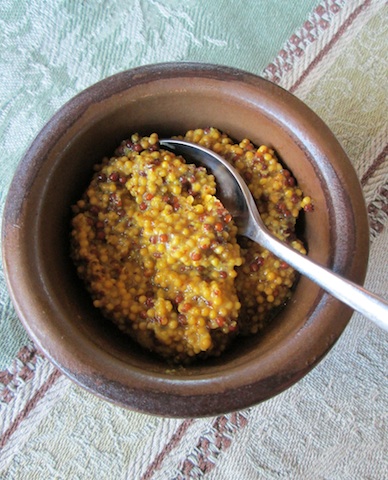
Whole seed mustard is a base ingredient in many foods. This mustard will start out fiery hot but will mellow with age.
There are many types of prepared mustard. In France, Dijon mustard is light in color and has a strong flavor. Bordeaux mustard is darker, with a mild flavor, and may include additives such as salt, vinegar, sugar and tarragon. Meaux mustard is mild and made from crushed mustard seeds rather than grinding seeds to a fine powder. German mustard is similar to Bordeaux mustard. English mustard is very strong. American-style yellow mustard is a mixture of the mildest mustard seeds with salt, vinegar, sugar, and turmeric. The turmeric gives mustard its characteristic color.
Homemade Lacto-Fermentation Whole Seed Mustard
Making homemade mustard is very easy. It will be fresher and of better quality than any mustard you can find commercially. Making your own mustard will also save money. This whole seed mustard is very much like the French Meaux Mustard. This recipe will get its vinegar-like flavor from lacto-fermentation. The mustard’s flavor will continue to “evolve” from the action of the live whey culture in your fridge over a number of months. The mustard will start as fiery hot and age into a mild, complex rich flavor.
1c brown mustard seeds
1T sea salt
1/4tsp turmeric (optional)
1/4c live whey culture
Take the mustard seeds and soak them for two days in filtered water. Change the water once or twice in a day. The mustard seeds should start to sprout during this time. (If they do not, find another source of seeds. The seeds are dead and have been given some sort of treatment to make the seeds store longer.) After the seeds have started to sprout, rinse the seeds one more time and pour off the water. Mix the mustard seeds, sea salt and turmeric, if desired. You can use any food processor to grind the seeds into a fine paste. Add more filtered water, if needed, for a smooth consistency. Store the mustard in a glass container. Add the live culture whey and let the mustard sit at room temperature for two days. This will activate the culture and make the mustard last for months in the fridge. The fresh mustard will start out very hot and mellow over time.
Live Whey Culture and Yoghurt Cream Cheese
Live whey culture is very easy to make. Use a cheese cloth bag or fine cotton cloth to drain the whey from homemade yoghurt. Whey is the whitish, watery material that comes off the yoghurt. If you continue to drain the yoghurt for about 24 hours, you will have a lovely yoghurt cream cheese. You can store live whey culture for months in the fridge.
Whole Seed Mustard Dressing
This is the salad dressing I always have available in my kitchen. It really is a convenience food and so easy to make.
1c extra virgin olive oil
1tsp sea salt
1/4c raw apple cider vinegar, raw wine vinegar or balsamic vinegar
1T cold-pressed sesame seed oil (optional)
1T whole seed mustard
1tsp raw local honey (optional)
After you ground your mustard seeds into a fine paste in the food processor, cleaning out the last of the mustard paste can be a chore. You can “clean” out your food processor by making some salad dressing. Add all of the ingredients together and blend. The mustard will emulsify the oils into a thick, creamy dressing. Store the dressing in a glass container in the fridge for easy use.
